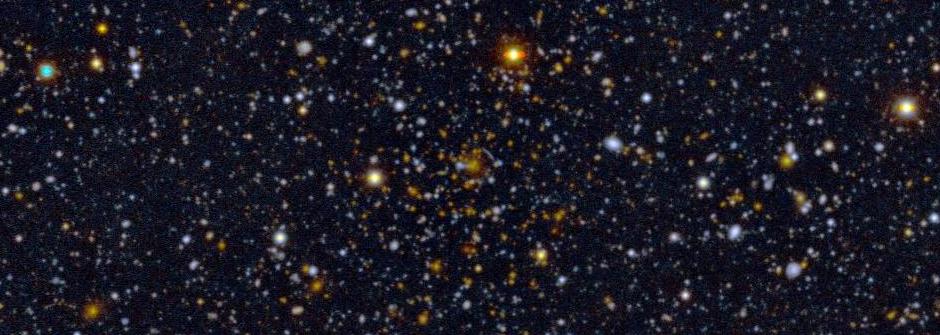Physics 250: Weak Lensing
MW 2:10-3:30pm in Physics 525CRN: 59613
Credits: 3
Instructor: David Wittman
www.physics.ucdavis.edu/~dwittman/phy250

High-redshift cluster of galaxies discovered
through its gravitational effects alone.
Physics 250: Weak LensingMW 2:10-3:30pm in Physics 525CRN: 59613 Credits: 3 Instructor: David Wittman www.physics.ucdavis.edu/~dwittman/phy250 |
 High-redshift cluster of galaxies discovered through its gravitational effects alone. |
|
Objective: Gravitational lensing is the most direct method of
observing dark matter, and it is "weak" for all but the densest lines
of sight in the universe (~1 gm cm-2). We will get
familiar with the methods of this new and rapidly developing field,
and look at the results with an eye to the larger context of
observational cosmology. If time permits, at the end of the quarter we may
take a look at strong lensing as well. Reading: You will save money because there is no textbook for this exciting new subject! Instead we will read accessible review articles and look at some recent papers with the latest developments in the field. There is a bibliography at the bottom of this page. Format: This will be a small class and highly interactive. Some class time will be devoted to cooperative group problem-solving. Reading assignments must be done before class so that you are ready to discuss them in class. Homework assignments may include researching open-ended questions and presenting the results to the class. Project: We will write the (currently nonexistent) Wikipedia article on weak lensing. Students are responsible for dividing the work and managing the project, subject to my review. Details will be announced soon. Because Wikipedia is at a somewhat lower level than a graduate course, each student will also make a more detailed presentation on his/her topic in the last week of class. Grading: 60% homework and 40% project (including final presentation). There will be no exams.
Schedule:
|
Gravitational Lenses, by Schneider, Ehlers, and Falco. There is almost nothing about weak lensing in this book, but it remains almost the only book-length introduction to lensing. On reserve in the library.
Gravitational Lensing:An Astrophysical Tool This little book is a set of five review papers as of 2003. Not held by the library, but you can get links to the chapters on ADS. Note: The chapters titled Quasar Lensing and Gravitational Optics Studies of Dark Matter Halos could be better titled Strong Lensing/Intro to Lensing and Galaxy-Galaxy Lensing respectively.
Gravitational Lensing: Strong, Weak and Micro: Saas-Fee Advanced Course 33 On reserve in the library.
Extragalactic Astronomy and Cosmology: An Introduction This will be a good reference for students who do not come from an astronomy background. For any topic in this huge field, you can get a brief summary at the level of an advanced undergraduate from this book. On reserve in the library.
This book has a chapter on lensing by Bartelmann, but I have not seen it.
Review Articles:
Narayan and Bartelmann 1996. This review is quite old, but it remains the best short introduction to the basics (of all lensing, not just weak).
Mellier 1999: Probing the Universe with Weak Lensing. A good all-around review, if a bit dated.
Bartelmann and Schneider 2001 All about weak lensing, heavy on the theory.
Wittman 2002 All about weak lensing, heavy on the observational aspects.
Making Measurements:
KSB: the seminal paper.
Bernstein and Jarvis 2002: representative of newer approaches.
Heymans et al (STEP 1): comparison of blind analyses by different groups.
Massey et al (STEP 2): blind analyses of more detailed simulations.
Miller et al: new method, Bayesian shape measurement.
GREAT08 Handbook: blind analysis challenge to the larger statistics community.
Clusters of Galaxies
Background reading about clusters in general
Online review by Biviano (2000): This is an extensive historical review of clusters as astrophysical laboratories. The HTML version pointed to here allows you to jump around easily. If you'd like a printable version, it is also available on the preprint archive. The history is fascinating at times (e.g., Zwicky's obituary in 1974 did not even mention his discovery of dark matter because it was not widely accepted at the time), but the review is too historical at times, if you are simply trying to learn about clusters. It also does not zoom out to include clusters as probes of cosmology. Still, I would recommend reading Section 4 at least.
1996 review by N. Bahcall: This review is older, but is straightforward physics without the historical development. It does discuss clusters as part of cosmology, but overall it reads a bit like a laundry list of cluster results, without much engaging discussion. Still, a good resource for quickly looking up anything to do with clusters.
Diaferio et al 2008: I settled on this as the required reading because it gives a lot of physical and cosmological context, is up to date, and is not too long. Its shortcoming is that it is not very long. By covering a lot of ground, it skips lightly over many areas. For instance, it has just one paragraph about lensing.
Additional papers mentioned in class: Hoekstra 2007 (lensing/X-ray relations); Kaiser & Squires 1993, Squires & Kaiser 1996, and Starck et al 2005 (making maps); Wittman et al 2006, Gavazzi & Soucail 2007, and others listed in my slides (shear selection).
Galaxy-galaxy lensing
Limousin et al 2007 contains, in the first two sections, a nice summary of the field. Consult references therein if you wish to dig deeper.
Cosmic shear
Hoekstra & Jain 2008: good up-to-date summary. Focuses on cosmic shear in sections 3-5, but you may find other sections useful as well.
Other
Handy "cheat sheets":
Keeton's catalog of mass profiles.
Hogg's summary of distance measures in cosmology. For a deeper understanding, consult a cosmology textbook such as Peebles or Dodelson.